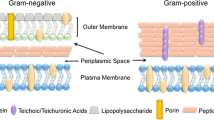Abstract
The bacterial cell to cell signalling system known as quorum sensing (QS) is essential for the regulation of virulence in many pathogens and offers a specific biochemical target for novel antibacterial therapies. Expanding on earlier work, in which consideration was given to the primary QS system (lasR system) in a homogeneous population of the common human pathogen Pseudomonas aeruginosa, we build a simple spatial model of an early-stage P. aeruginosa biofilm subject to treatment with topically applied anti-QS drugs (of two specific kinds) and conventional antibiotics. In the case of a slowly growing biofilm we show that both kinds of anti-quorum sensing drug are effective in reducing the level of the relevant signal molecule (3-oxo-C12-homoserine lactone; henceforth AHL), in each case obtaining an explicit bound on the steady-state AHL profile in terms of a prescribed surface drug concentration. Using numerical methods, we are also able to reproduce the hysteretic phenomena exhibited by the homogeneous model, in particular showing that for each kind of anti-QS drug there is a parameter regime in which a catastrophic collapse occurs in the steady-state AHL concentration as the surface drug concentration passes some critical value; an alternative way of interpreting this result is to say that, for a prescribed surface drug concentration, there is a critical biofilm depth such that treatment is successful until this depth is reached, but fails thereafter. In the thick-biofilm limit we show that the critical concentration of each drug increases exponentially with the biofilm thickness (or, conversely, that the critical depth increases logarithmically with surface drug concentration); this is dramatically different to the behaviour observed in the corresponding homogeneous model, where the critical concentrations grow linearly with bacterial carrying capacity, and thus highlights the relative difficulty of treating a large, spatially-structured population with diffusing antibacterials.
Similar content being viewed by others
References
Anguige, K., King, J.R., Ward, J.P., Williams, P.: Mathematical modelling of therapies targeted at bacterial quorum sensing. Math. Biosci. 192, 39–83 (2004)
Britton, N.F.: Reaction-Diffusion Equations and Their Applications to Biology. Academic Press, 1986
Chopp, D.L., Kirisits, M.J., Moran, B., Parsek, M.R.: The dependence of quorum sensing on the depth of a growing biofilm. Bull. Math. Biol. 65, 1053–1079 (2003)
Dockery, J.D., Keener, J.P.: A mathematical model for quorum sensing in Pseudomonas aeruginosa. Bull. Math. Biol. 63, 95–116 (2001)
Dong, Y., Gusti, A., Zhang, Q., Xu, J., Zhang, L.: Identification of Quorum-Quenching N-Acyl Homoserine Lactonases from Bacillus Species. Appl. Environ. Microbiol. 68, 1754–1759 (2002)
Lee, S., Park, S., Lee, J., Yum, D., Koo, B., Lee, J-K.: Genes Encoding the N-Acyl Homoserine Lactone-Degrading Enzyme Are Widespread in Many Subspecies of Bacillus thuringiensis. Appl. Environ. Microbiol. 68, 3919–3924 (2002)
Manefield, M., De Nys, R., Kumar, N., Read, R., Givskov, M., Steinberg, P., Kjelleberg, S.: Evidence that halogenated furanones from Delisea pulchra inhibit acylated homoserine lactone (AHL)-mediated gene expression by displacing the AHL signal from its receptor protein. Microbiol. 145, 283–291 (1999)
Manefield, M., Rasmussen, T.B., Hentzer, M., Andersen, J.B. Steinberg, P., Kjelleberg, S., Givskov, M.: Halogenated furanones inhibit quorum sensing through accelerated LuxR turnover. Microbiol. 148, 1119–1127 (2002)
Rumbaugh, K.P., Griswold, J.A., Iglewski, B.H., Hamood, A.N.: Contribution of quorum sensing to the virulence of Pseudomonas aeruginosa in burn wound infections. Infect. Immun. 67, 5854–5862 (1999)
Ward, J.P., King, J.R., Koerber, A.J., Williams, P., Croft, J.M., Sockett, R.E.: Early development and quorum sensing in bacterial biofilms. J. Math. Biol. 47, 23–55 (2003)
Ward, J.P., King, J.R., Koerber, A.J., Williams, P., Croft, J.M., Sockett, R.E.: Mathematical modelling of quorum sensing in bacteria. IMA J. Math. Appl. Med. Biol. 18, 263–292 (2001)
Williams, P.: Quorum sensing: an emerging target for antibacterial chemotherapy?. Expert Opin. Ther. Targets 6, 257–274 (2002)
Winzer, K., Williams, P.: Quorum sensing and the regulation of virulence gene expression in pathogenic bacteria. Int. J. Med. Microbiol. 291, 131–143 (2001)
Author information
Authors and Affiliations
Corresponding author
Rights and permissions
About this article
Cite this article
Anguige, K., King, J. & Ward, J. Modelling antibiotic- and anti-quorum sensing treatment of a spatially-structured Pseudomonas aeruginosa population. J. Math. Biol. 51, 557–594 (2005). https://doi.org/10.1007/s00285-005-0316-8
Received:
Revised:
Published:
Issue Date:
DOI: https://doi.org/10.1007/s00285-005-0316-8




